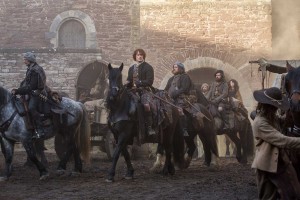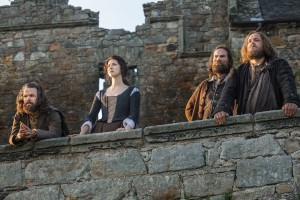
Back in 2009 when Battlestar Galactica was wrapping up its successful series run, executive producer Ron Moore‘s wife, Terry Dresbach, and his producing partner Meryl Davis began talking about a book series they had loved entitled Outlander, by Diana Gabaldon. Two time Emmy nominated editor Michael O’Halloran, an editor on Battlestar, who had worked with Moore previously on Star Trek: Voyager, had worked with Moore on all his projects and was also looking forward to future endeavors. A few years later, when Moore was able to bring the historical fiction to Starz, the team reunited to start another chapter.
Outlander begins through the eyes of Claire Randall Fraser (Caitriona Balfe), a married, World War II field nurse who is abruptly swept back in time to Scotland circa 1743. She finds herself in immediate danger in her new 18th-Century surroundings, but meets a sexy, chivalrous Scottish warrior, Jamie Fraser (Sam Heughan). Forced to marry Fraser when her life is threatened, the newlyweds go on to battle Black Jack Randall (Tobias Menzies). Claire is never portrayed as a victim however, and takes control of her bewildering circumstances to carve out a strong woman’s role. This highlighting of romance, albeit through a strong female lens, is surely one of the many reasons the show has found an audience. Another is that it employs the engaging literary device of shifting character perspectives. When Outlander returned after hiatus, the audience was now viewing the story through character Jamie’s, not Claire’s, eyes. This technique serves not simply to spotlight the male gaze, but offers more insight into Jamie’s character as well.

O’Halloran got his break in the industry as a production associate on Star Trek: Voyager. He also worked in the writers’ room where he would see the scribes brainstorming and he learned to break down a story. When he became the sort of unofficial liaison between the writing room and the editing suite, he learned the editors’ vernacular and found his niche. Understanding story helped him secure a job as assistant editor, and he was hooked.
Although O’Halloran calls Los Angeles home, he’s been able to spend seven months in Scotland while on the job and couldn’t love it more. Above and beyond the sublime beauty of the country, one of the benefits of the job is that working on Outlander is “not as tight as a network schedule,” he shared. “They have 16 days to shoot, and we’re not up against air dates. Sony is really great! We typically have about two working weeks (10 days) per episode to edit and it makes a big difference for us.” It’s a non-DGA show, so they have some autonomy. While O’Halloran works closely with Ron Moore, he explained that the directors are involved in editorial, “because they do their cut over in Scotland with the assembly editors. I’m the supervising editor, so I then take the cut over after the director is finished and polish/recut while also doing producer and studio notes here in L.A.”
 Going forward with this epic tale, O’Halloran can tell us that the scope gets even bigger. The next season will involve more exteriors and the writers have expanded on the celebrated book series. With 20 million books sold internationally before it was even turned into a television show, the production enjoys a built-in audience. And that audience can rest easy knowing there are eight books to mine for exciting content, and that author Diana Gabaldon trusts the cast and crew to escort the beloved story into an assuredly bright future.
Going forward with this epic tale, O’Halloran can tell us that the scope gets even bigger. The next season will involve more exteriors and the writers have expanded on the celebrated book series. With 20 million books sold internationally before it was even turned into a television show, the production enjoys a built-in audience. And that audience can rest easy knowing there are eight books to mine for exciting content, and that author Diana Gabaldon trusts the cast and crew to escort the beloved story into an assuredly bright future.





